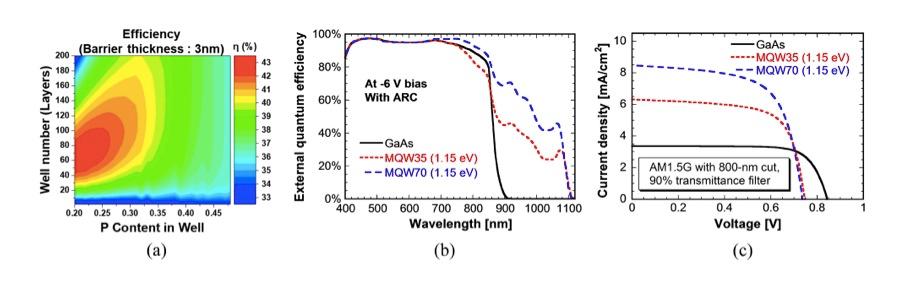■ Example of research topics ■
[ Solar ]
1. 4 junction by wafer bonding /
2. High-speed MOVPE /
3. EL and PL characterization /
4. Thin-film multi-junction (design and light trapping) /
5. 1.15 eV middle cell with MQWs /
6. Theoretical modeling of MQWs (quasi bulk approach and cell design) /
7. WoW /
8. ELO /
9. Dilute nitride MQW
[ Growth ]
1. III-V on Si photo detector /
2. III-V on Si solar cell
[ LED ]
1. Chip-white LED
[ Solar Fuel ]
1. CPV + water electrolysis /
2. CO2 reduction /
3. Semiconductor/electrolyte interface /
4. Polarization-controlled nitride photocathode /
5. Design of energy management system using hydrogen-based power storage
[ Quantum Modeling ]
1. Quantum modeling of insulators
Strain-balanced multiple quantum wells for efficiency enhancement of multi-junction solar cells
K. Toprasertpong, B. Kim, H. -H. Huang, K. Watanabe, Y. Nakano, and M. Sugiyama
Multi-junction solar cell can improve the energy conversion efficiency of conventional solar cells, from < 30% to > 40%, by stacking materials with different bandgaps, which efficiently absorb a wide range of the solar spectrum. A set of materials with the optimal bandgap combination, the lattice constant matched with the underlying substrate, and high material quality are necessary to maximize the efficiency of multi-junction solar cells. For instance, bandgap in a range of 0.7 - 1.4 eV and 1.5 - 1.9 eV is required in the Ge-based and 1.2 - 2.0 eV is required in the Si-based multi-junction cells. We introduce InGaAs/GaAsP, GaAsP/GaAsP, and InGaP/InGaP strain-balanced multiple quantum wells as materials satisfying the above requirements: they can be kept pseudo-lattice-matched with the underlying substrate while their bandgaps are adjustable. Furthermore, the high luminescence efficiency of quantum wells is expected to boost the open-circuit voltage of the cell. Our research ranges from the device modeling, simulation of electrical properties, crystal growth of thin-film solar cells by the metal-organic vapor phase epitaxy technique, to the evaluation of device performance.

Fig. (a) Efficiency estimation of multi-junction solar cell including GaAsP/GaAsP strain-balanced quantum wells. Measured (b) quantum efficiency and (c) current-voltage characteristics of InGaAs/GaAsP strain-balanced quantum well solar cells.